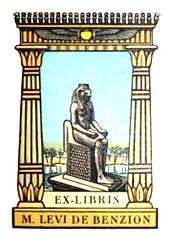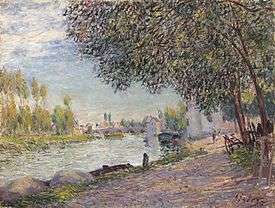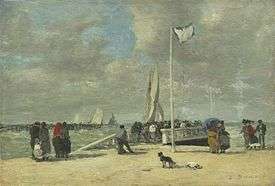Moïse Lévy de Benzion
Moïse Lévy de Benzion (1873–1943) was an Egyptian department store owner who built an important collection of art and antiquities. The collection was plundered by the Nazis in France during the Second World War and nearly 1000 items seized.

.jpg)


Egypt
Lévy de Benzion was a Sephardi Jew born in Alexandria, Egypt, in 1873.[1] He inherited a family business started in 1857[2] which he expanded to include the Grands Magasins Benzion department store and other buildings in Cairo. As a collector, Lévy de Benzion's acquisitions included Chinese and oriental art, textiles, carpets, books, and an important collection of Egyptian antiquities.[3][4] His Egyptian items included fragments from the lost tomb of Nebamun,[1] and one of the earliest known glass portraits, believed to depict Amenhotep II.[5]
France
During the Second World War, Lévy de Benzion's collections in Paris and the chateau "La Folie" in Draviel were extensively looted by units of the Einsatzstab Reichsleiter Rosenberg (ERR), the Nazi unit charged with following behind invading German troops and identifying and seizing works of art from occupied countries. Records of the ERR indicate that 989 items were seized from the Lévy de Benzion collection alone.[6]
Typical of the handling of the looted paintings was Gustave Courbet's Entree d'un Gave (1876).[7] Lévy de Benzion acquired the painting in 1919; the ERR seized it in 1940 and moved it to the Neuschwanstein castle. In 1941 it was acquired by Walter Hofer for the Hermann Göring collection.[8] Göring, however, was not interested in modern art, preferring Old Master paintings instead, and the work was among a number of modern paintings subsequently exchanged for older works selected from Theodor Fischer's Galerie Fischer in Lucerne.[9][10] Fischer sold the painting to Willi Raeber of Basel, who in turn sold it to Galerie Rosengart of Lucerne, who sold it to Arthur Stoll. After the war, the painting was claimed by Paule-Juliette Levi de Benzion of Cairo and restituted to her in 1948. After changing hands several more times, it was sold to the Birmingham Museum of Art in Alabama in 1999.[11]
Among the other works seized and later returned were paintings by Eugène Boudin, Jean-Baptiste-Camille Corot, Charles Cottet, Charles Daubigny, Claude Monet, Alfred Sisley, and Vincent van Gogh.[4][12][13][14]
Death
Lévy de Benzion was arrested by the Nazis in France and died in September 1943.[1][2] His collection was sold at auction at Villa Benzion, 6 Rue El Amir Omar, Zamalek, Cairo, in March 1947 in a sale of over 900 lots.[15] Villa Benzion was in a part of Zamalek where several other department-store owners lived, but like many other large private houses in the area, it no longer exists.[16]
See also
References
- A happy ending with a pinch of Salt. Archived 2013-07-15 at the Wayback Machine Al-Ahram Weekly Online, 19-25 March 2009, No. 939. Retrieved 20 January 2015.
- "Levy de Benzion, Moise (1873–1943)", Carstens, Patrick Richard. (2014). The Encyclopædia of Egypt during the Reign of the Mehemet Ali Dynasty 1798–1952. Victoria BC: Friesen Press. p. 421. ISBN 978-1-4602-4898-0.
- Sauf-Conduit de Moïse Lévi de Benzion, valable pour un seul déplacement pendant 15 jours Marseille, Poste de la gendarmerie Nationale, 15 mai 1941 Valable pour un an MAHJ Archives AR 776. Musée d'art et d'histoire du Judaïsme. Retrieved 21 January 2015.
- "Levi de Benzion, Moïse". Lost Art. Retrieved 20 January 2015.
- Portrait of King Amenhotep II (?) Corning Museum of Glass. Retrieved 22 January 2015.
- Harclerode, Peter, & Brendan Pittaway. (1999) The Lost Masters: The Looting of Europe's Treasurehouses. London: Victor Gollancz, p. 44. ISBN 0-575-05254-6
- Un Tableau D'Alred Sisley Provenant de L'Anciienne Collection Moïse Levy de Benzion et Estimé 600 000 / 800 000 €. drouot.com Retrieved 22 January 2015.
- "Monuments Man: Birmingham Museum of Art's founding director Richard Howard helped restitute Nazi-plundered art." Michael Huebner, AL.com, 7 February 2014. Retrieved 20 January 2015.
- Harclerode, p. 128.
- ALIU Detailed Interrogation Report: Hans WENDLAND, 18 September 1946. lootedart.com. Retrieved 26 January 2015.
- Yeide, p. 456, D22.
- Post-War Reports: Art Looting Intelligence Unit (ALIU) Reports 1945–1946 and ALIU Red Flag Names List and Index. lootedart.com. Retrieved 21 January 2015.
- Yeide, Nancy H. (2009) Beyond the Dreams of Avarice: The Hermann Goering Collection. Dallas: Laurel Publishing, pp. 180 & 393, A1288. ISBN 0-9774349-1-5
- On the Jetty c. 1869/1870. National Gallery of Art. Retrieved 9 February 2015.
- Catalogue des tableaux, aquarelles, dessins, bronzes, objets d'art, &c. Brookmuse. Retrieved 21 January 2015.
- "The House That Shrunk On Zamalek's Hassan Sabry Street" Samir Raafat, Cairo Times, 28 September 2000. egy.com Retrieved 22 January 2015.